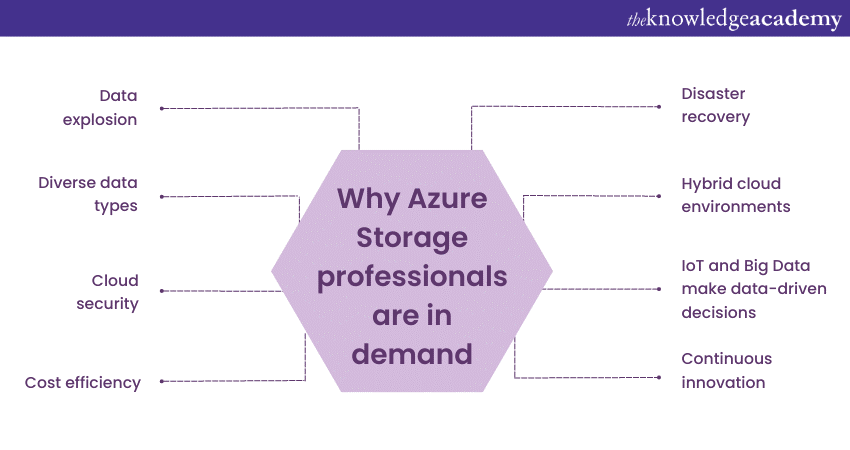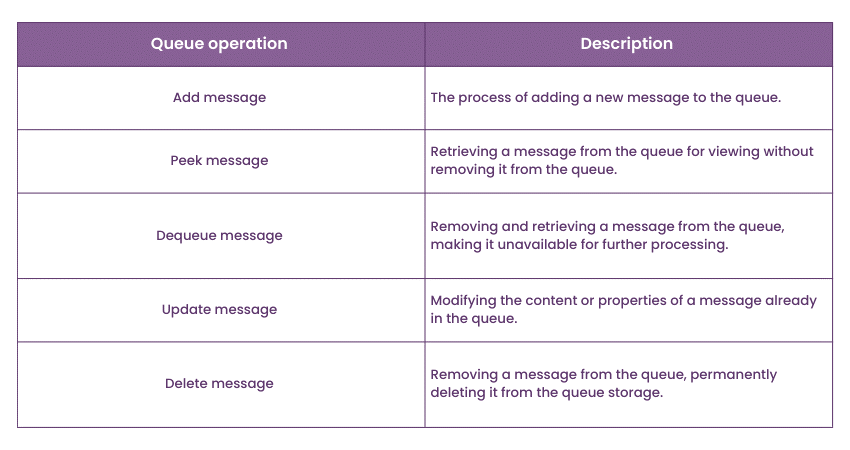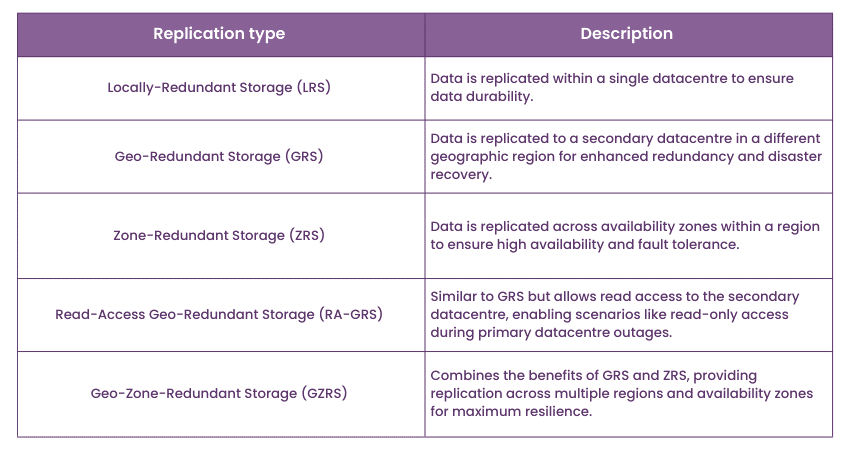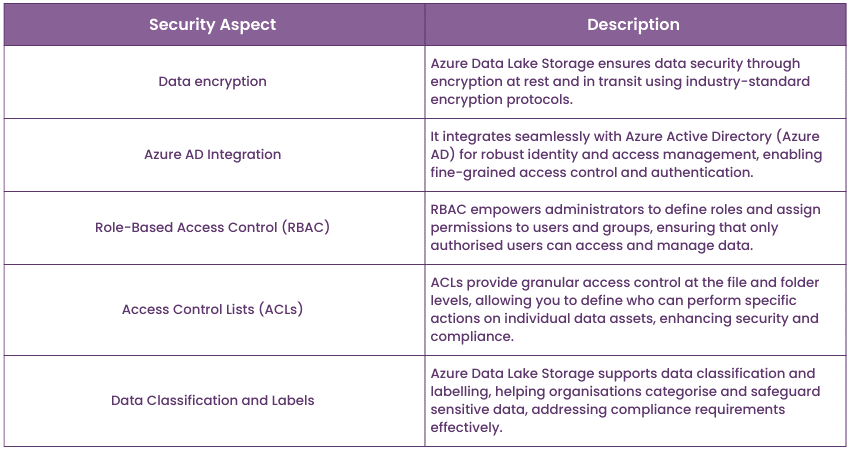We may not have the course you’re looking for. If you enquire or give us a call on +357 26030221 and speak to our training experts, we may still be able to help with your training requirements.
Training Outcomes Within Your Budget!
We ensure quality, budget-alignment, and timely delivery by our expert instructors.
- Retired : Designing and Implementing Enterprise-Scale Analytics Solutions Using Microsoft Azure and Microsoft Power BI DP500
- Microsoft Azure Administrator AZ104
- Data Engineering On Microsoft Azure DP-203 Certification
- Microsoft Azure Security Technologies AZ500
- Designing And Implementing Microsoft DevOps Solutions AZ400

Azure Storage Interview Questions can be stressful whether you're starting your career or aiming to advance in Cloud Computing. Azure Storage is a vital component of Microsoft's cloud platform and mastering it can open doors to exciting opportunities.
According to Microsoft, revenue from server products and cloud services surged by 17%, primarily propelled by Azure in 2023. Azure Storage plays a pivotal role in Cloud Computing, offering a suite of scalable, secure, and versatile storage services that are indispensable in today's digital landscape.
If you're gearing up for an interview, you're in the right place. We're here to break down the essential Interview Questions and provide clear answers. Whether you're a beginner or an experienced pro, this blog will help you understand Azure Storage Interview Questions better and ace your interview
Table of Contents
1) The demand for Azure Storage professionals
2) Questions on Azure Storage fundamentals
3) Blob Storage Interview Questions
4) Table Storage Interview Questions
5) Queue Storage Interview Questions
6) File Storage Interview Questions
7) Interview questions on advanced topics
8) Azure Data Lake Storage Interview Questions
9) Conclusion
The demand for Azure Storage professionals

Microsoft Azure is one of the leading Cloud platforms globally, and its usage continues to expand rapidly. As more businesses migrate their operations and data to Azure, there's an increasing need for professionals who can effectively manage and optimise Azure Storage services.
The demand for Azure Storage professionals is on the rise due to several key factors, including:
a) Data explosion: In today's data-driven world, the volume of data businesses generate is exploding. Azure Storage provides scalable solutions for handling large datasets, making professionals skilled in its usage highly sought after.
b) Diverse data types: Azure Storage supports various data types, from unstructured files to structured databases. Professionals who understand how to work with different data formats and optimise storage resources are in high demand.
c) Cloud security: with Azure Pipelines facilitating the implementation of secure deployment processes and compliance checks for maintaining data integrity throughout the storage lifecycle.
d) Cost efficiency: Azure Storage offers cost-effective storage solutions, but optimising costs while ensuring efficient Data Management requires specialised skills. Businesses are eager to find professionals who can balance performance with cost-effectiveness.
e) Disaster recovery: Azure Storage plays a critical role in disaster recovery strategies. Professionals who can design and implement reliable backup and recovery solutions are essential for ensuring business continuity.
f) Hybrid cloud environments: Many organisations operate in hybrid cloud environments, combining on-premises infrastructure with Azure services. Professionals who can seamlessly integrate Azure Storage with existing systems are precious.
g) IoT and Big Data: The Internet of Things (IoT) and Big Data applications generate massive amounts of data. Azure Storage professionals must manage and analyse this data efficiently, enabling businesses to derive insights and make data-driven decisions.
h) Continuous innovation: Azure Storage services evolve with new features and capabilities. Professionals who stay current on advancements and implement innovative solutions are in high demand.
Elevate your skills and career with Microsoft Azure Training - join now and harness the power of the cloud!
Questions on Azure Storage fundamentals
Azure Storage, a pillar of Microsoft Azure, is a Cloud Storage solution offering versatile services vital for businesses to store, manage, and secure data efficiently in the digital age.
1) What is Azure Storage?
Azure Storage is the Cloud-based storage solution provided by Microsoft Azure. It provides a secure and scalable virtual storage for various data types. Think of it as your digital warehouse in the cloud, offering the flexibility to keep everything from documents and images to databases and backups, showcasing the comprehensive capabilities found in Microsoft Azure Cloud Features and Benefits.
Azure Storage is a foundational component of Azure's Cloud services, allowing businesses to store, access, and manage their data anywhere securely. It's designed to be highly available, durable, and cost-effective, making it an essential part of cloud-based applications and data-driven solutions.
2) What are the types of Azure Storage services?

Azure Storage offers several specialised services, each tailored to specific data storage needs:
a) Blob Storage: This service is perfect for storing unstructured data, like files, images, and videos. Storing and managing large amounts of data is made efficient, scalable, and cost-effective. Effective Data Management is achieved through redundancy, versioning, and access control.
b) Table Storage: Table Storage is a NoSQL data store suitable for structured data. It's commonly used for applications requiring fast and scalable data access, like IoT and web applications.
c) Queue Storage: Queue Storage facilitates communication between different components of distributed applications. It enables reliable message queuing for improved system efficiency.
d) File Storage: Azure File Storage allows you to create network file shares in the cloud, making it easy to share files across multiple virtual machines and on-premises systems.
3) Explain Storage account.
A storage account in Azure is like the gateway to your Azure Storage resources. It is a unique identity for your storage services and provides access keys and endpoints to interact with your data. When setting up a storage account, you have the flexibility to tailor its performance and characteristics to align with your precise requirements. Multiple attributes are at your disposal, allowing you to make choices that guarantee the ideal and secure operation of your storage account. This flexibility, along with the ability to choose various attributes for optimal and secure operation, is a key topic covered in Microsoft Azure Interview Questions.
There are different types of storage accounts available, including:
a) General purpose v2: This is the most versatile and commonly used storage account type. It supports all Azure Storage services and balances performance, scalability, and cost-efficiency.
b) Blob Storage: If your primary objective revolves around the storage of extensive quantities of unorganised data such as images, videos, or backups, Blob Storage accounts are specifically designed for this task, providing tailored functionalities and pricing options.
c) File Storage: For creating Azure File Shares, you can use File Storage accounts. These are designed specifically for file-sharing scenarios.
d) Premium Storage: Premium Storage accounts offer high-performance Solid-State Drive (SSD) Storage and are typically used for workloads requiring low-latency access to data.
Blob Storage Interview Questions
Azure Blob Storage, a core Azure service, is your Cloud storage solution for versatile data types. Read further to learn about its types, containers, pricing, and security:
4) What is Blob Storage?
Azure Blob Storage, a product offered by Microsoft Azure, is a Cloud-based service primarily built to handle extensive volumes of unstructured data, including but not limited to documents, images, videos, and backups. Its notable characteristics encompass exceptional scalability and durability, rendering it applicable to diverse use cases, spanning from data archiving to content delivery for web and mobile applications.
5) What are Blob types?
The Blob types are:
a) Block Blobs: Block Blobs are designed for efficient storage and retrieval of large files, making them ideal for media streaming and data backups. These blobs consist of data blocks that can be uploaded concurrently, enhancing their suitability for scenarios that require high-speed data transfer. For more details on how these concepts are applied, you might find Dynamics 365 Interview Questions particularly relevant.
b) Page Blobs: Page Blobs cater to random read and write operations, commonly employed with Virtual Machines. They serve as the foundational storage for Azure Virtual Machines, ensuring low-latency data access. Page Blobs are particularly well-suited for applications demanding rapid and precise data manipulation.
c) Append Blobs: Append blobs are optimised for append operations. They are often used for scenarios like logging, where you need to add data to a blob without modifying the existing content. They are efficient for frequent write operations.
6) What are Blob Containers?
Azure Blob Containers are logical containers within Azure Blob Storage, a component of Microsoft Azure's Cloud Storage services. These containers are like folders for organising stuff in your online storage. They help you group and manage your files, making it easier to store and access them in Microsoft Azure's Cloud Storage service.
7) Describe Blob Storage pricing.
Blob Storage pricing depends on several factors, including storage capacity, data transfer, and access operations. There are different pricing tiers, such as Hot and Cool, offering varying levels of storage costs and access frequency. Understanding the pricing model and choosing the right tier for your data usage patterns is essential for cost optimisation.
8) Explain security and access control in Blob Storage.
Security in Azure Blob Storage is paramount. Azure provides several mechanisms to secure your blob data, including:
a) Shared Access Signatures (SAS): SAS tokens grant limited-time access to specific blobs or containers, allowing you to control who can access your data and for how long.
b) Role-Based Access Control (RBAC): Azure RBAC lets you assign specific roles to users or applications, granting them permissions to manage and access blob data within your Azure Storage account.
c) Encryption: Data at rest is encrypted, and you can enable encryption in transit for an extra layer of security.
d) Firewalls and virtual networks: You can restrict access to your storage account to specific IP addresses or virtual networks, enhancing security.
Discover your potential with our Microsoft Azure Big Data Analytics Solutions M552241 Course and harness data-driven insights for your organisation's success.
Table Storage Interview Questions
Azure Table Storage is a versatile and cost-effective option for storing structured data in the cloud. Understanding its data model, querying capabilities, scalability principles, and pricing factors will help you harness its full potential for various application scenarios.
9) What is Azure Table Storage?
Azure Table Storage is a NoSQL data store in the cloud that allows you to store structured data in a schema-less format. It is part of Microsoft's Azure Storage offering and is particularly well-suited for storing semi-structured or structured data in a highly scalable and cost-effective manner. Instead of traditional relational databases, Azure Table Storage uses a key/attribute store paradigm, which contrasts with the Key Constraints in SQL used in relational database systems. This makes it ideal for scenarios like IoT, web applications, and log data storage.
10) Explain the data model in Table Storage.
Azure Table Storage employs a simple data model consisting of tables, entities, and properties:
a) Tables: Tables are containers for storing entities. Each table can be thought of as a collection of related data.
b) Entities: Entities are the individual records within a table. They have a primary key that uniquely identifies them within the table.
c) Properties: Entities have properties, which are name-value pairs. Properties can be of different data types (e.g., string, integer, datetime) and allow you to store the actual data.
11) What is Querying Data in Azure Table Storage?
Querying Data in Azure Table Storage involves using the OData protocol. You can perform various queries, including filtering, projection, and sorting, to retrieve specific data from your tables. Understanding how to construct efficient queries is essential to optimise data retrieval performance.
12) Explain scalability and partitioning in Azure Table storage.
Azure Table Storage is designed for scalability. It uses a partitioning scheme to distribute data across multiple servers to handle high volumes of data and requests. Each table is divided into partitions, and each partition can contain a subset of entities.
By choosing an appropriate partition key, you can optimise data distribution and retrieval performance. However, it's crucial to design your partitioning strategy carefully to avoid hot partitions (partitions with high data or request rates).
13) What are the factors which affect the pricing plans of Azure Table Storage?
Pricing for Azure Table Storage is based on factors like the number of transactions (e.g., insert, retrieve, delete operations), the amount of data stored, and data transfer costs. To optimise costs, consider the following:
a) Use appropriate indexing to enhance query performance
b) Leverage batch operations to reduce transaction costs
c) Implement data retention and cleanup policies to manage storage costs
d) Monitor and adjust your scalability as needed to accommodate data growth
Elevate your Cybersecurity expertise with our Microsoft Azure Security Technologies AZ-500 Training and become a guardian of the cloud.
Queue Storage Interview Questions
Azure Queue Storage is a cloud-based service designed for managing and processing messages in a distributed system. It enables communication and coordination between different components of an application or Microservices Architecture. Queues act as temporary storage for messages, facilitating asynchronous processing and decoupling of system components.
14) What are Queue Operations?
Queue operations in Azure Storage refer to actions that you can perform on Azure Queue Storage. Queue operations include the following:

a) Adding messages: You can add messages to an Azure Queue using the "enqueue" operation. Messages are typically added to the end of the queue and await processing.
b) Peeking messages: The "peek" operation allows you to view a message in the queue without removing it. This is useful for inspecting messages before processing.
c) Dequeuing messages: Dequeuing, or "taking" messages, removes a message from the front of the queue for processing. Once processed, you can delete the message from the queue.
15) Explain Message durability and security in Azure Queue Storage.
Message durability: Azure Queue Storage provides multiple levels of durability for messages. Messages can be stored with redundancy to ensure they are not lost in case of hardware failures. It offers options like Locally Redundant Storage (LRS) and Geo-Redundant Storage (GRS) for data redundancy.
Security: Azure Queue Storage seamlessly incorporates Azure Active Directory (Azure AD) for authentication and access management. It allows you to set up access policies, utilise Shared Access Signatures (SAS), and implement Role-Based Access Control (RBAC) to administer and safeguard access to your queues effectively.
16) Explain the pricing model and scaling in Azure Queue Storage.
Pricing model: Azure Queue Storage pricing is based on the number of transactions (operations) performed, the amount of data stored, and data transfer costs. Understanding the pricing model and optimising usage can help control costs.
Scaling: Azure Queue Storage is designed to handle a high volume of messages and can automatically scale to accommodate increased workloads. Properly designing your queue-based architecture and monitoring usage is essential for scaling efficiently.
Take your first step toward becoming a Microsoft Azure expert with Developing Solutions For Microsoft Azure AZ204 Course. Elevate your skills and open doors to endless opportunities in cloud development.
File Storage Interview Questions
Azure File Storage, a cloud-based file-sharing solution from Microsoft Azure, empowers users to establish cloud-based file shares accessible from numerous Virtual Machines (VMs) and on-site systems. This service operates on the Server Message Block (SMB) protocol, ensuring compatibility with Windows and Linux environments alike.
17) What is SMB and NFS support of Azure File Storage
SMB support: Azure File Storage fully supports the SMB protocol, which is commonly used in Windows-based environments. This means you can easily mount Azure file shares as network drives on Windows-based machines, providing seamless file access.
NFS support: Azure File Storage also offers limited preview support for the Network File System (NFS) protocol, widely used in Linux and Unix environments. This enables Linux VMs to mount Azure file shares and access files using NFS.
18) What is data migration of Azure File Storage?
Data migration is categorised into three categories which are:
a) Azure Data Box: For large-scale data migration to Azure File Storage, Azure offers services like Azure Data Box, a physical appliance you can use to transfer large amounts of data securely to the cloud. This can be especially useful for initial data seeding.
b) Azure Data Factory: Azure Data Factory, a cloud-native data integration service, empowers you to design data-driven workflows that facilitate the seamless transfer of data between on-premises and cloud-based data repositories, including Azure File Storage.
c) Robocopy and AzCopy: You can use tools like Robocopy (for Windows) and AzCopy (a command-line tool provided by Azure) for more granular data migration tasks. These tools allow you to copy files and directories to and from Azure file shares.
19) Explain the pricing model and performance of Azure File Storage
Pricing model: Azure File Storage pricing is based on the amount of data stored in your file shares and the number of operations performed (e.g., reads, writes, and data transfer). It's important to understand the pricing model to manage costs effectively.
Performance considerations: To optimise performance, you can consider factors such as the redundancy level of your file shares (locally redundant or geo-redundant), the tier of storage used (standard or premium), and the network bandwidth between your VMs and Azure File Storage. The performance characteristics of Azure File Storage are designed to meet a range of application needs.
Interview questions on advanced topics
Advanced topics in Azure Storage consist of data replication, data backup and recovery, and monitoring and management and goes beyond the basics to help you implement robust data protection, availability, and performance strategies in your Azure environment. Understanding these topics is essential for ensuring the reliability and resilience of your storage solutions.
21) What is data replication in Azure Storage?
Azure Storage offers several replication options to meet different availability and redundancy requirements which are mentioned below:

a) Locally Redundant Storage (LRS): LRS replicates your data within a single data centre to protect against local hardware failures. It's cost-effective and provides a degree of data resilience.
b) Geo-Redundant Storage (GRS): GRS takes data replication a step further by creating an additional copy of your data in a secondary Azure region, typically hundreds of miles away from the primary region. This provides higher resilience against regional outages, ensuring data availability even in the face of major disasters.
c) Read-Access Geo-Redundant Storage (RA-GRS): This option builds upon GRS by allowing read access to the secondary region. It's beneficial for scenarios requiring data access during primary region outages and for read-heavy workloads.
22) Explain data backup and recovery in Azure Storage.
Data backup and recovery are important components of a robust Data Management strategy. Azure Storage offers various features and tools for data protection:
a) Azure Backup: Azure Backup is a fully administered backup system that safeguards your data residing within Azure Storage. It caters to both file-level and VM-level backup needs, offering choices for data retention and retrieval.
b) Azure Site Recovery: Azure Site Recovery is designed for disaster recovery scenarios, allowing you to replicate VMs and their associated data to another Azure region or an on-premises location.
c) Azure Blob Versioning: Blob Versioning helps protect against accidental data deletion or corruption by maintaining a historical record of changes to your blobs. This feature ensures that you can recover previous versions of your data when needed.
23) Explain monitoring and management in Azure Storage
Effective monitoring and management are key to maintaining the health and performance of Azure Storage resources:
a) Azure Monitor: Azure Monitor provides a centralised platform for monitoring Azure resources, including Azure Storage. It offers insights into performance, availability, and security, helping you proactively identify and resolve issues.
b) Azure Storage Explorer: Azure Storage Explorer is a graphical tool that simplifies the management of Azure Storage resources. It allows you to view and manage your storage accounts, containers, and blobs, making it easier to perform common tasks.
c) Azure Resource Manager (ARM) Templates: ARM Templates enable you to define and deploy Azure Storage resources as code. This approach promotes automation, versioning, and consistency in resource management.
Start your journey into Cloud Computing with our Microsoft Azure Fundamentals AZ-900 Course - join now and elevate your cloud skills!
Azure Data Lake Storage Interview Questions
Here are some interview questions on Azure Data Lake Storage:
24) What is Azure Data Lake Storage, and why is it important in the Azure ecosystem?
Azure Data Lake Storage is a scalable and secure data lake solution provided by Microsoft Azure. It allows organisations to store and manage vast amounts of data, including structured, semi-structured, and unstructured data. It is important in the Azure ecosystem because it serves as a central repository for Big Data and analytical workloads.
Data stored in Data Lake Storage can be easily integrated with various Azure services like Azure Databricks, Azure Data Factory, and Azure HDInsight for advanced analytics, Machine Learning, and data processing. Its limitless storage capacity and tight integration with Azure services make it a fundamental component for modern data-driven applications.
25) What types of data can be stored in Azure Data Lake Storage?
Azure Data Lake Storage supports a wide range of data types, including text, binary, JSON, Parquet, Avro, and more. This flexibility allows organisations to store diverse data formats commonly used in modern data analytics and processing scenarios.
Whether it's log files, sensor data, images, videos, or structured data, Azure Data Lake Storage can accommodate various data types, making it a versatile solution for handling different data sources.
26) What are the key features of Azure Data Lake Storage, and how do they benefit data storage and processing?
Azure Data Lake Storage offers several key features:
a) Limitless storage capacity: It can scale to store petabytes of data, accommodating the ever-growing data needs of organisations.
b) High input: High-speed data access is critical for real-time analytics and data processing. With high input capabilities, organizations can ingest and retrieve data quickly, which is essential for applications that require immediate insights from the data.
c) Integration with analytics services: Azure Data Lake Storage seamlessly integrates with Azure analytics services like Azure Databricks and Azure Synapse Analytics, enabling powerful data processing and insights.
d) Hierarchical namespace: The hierarchical structure helps organise data efficiently, making it easier to manage and access large datasets. It also improves data query performance.
27) What are some common use cases for Azure Data Lake Storage?
Azure Data Lake Storage serves as a foundational component for various data-related use cases, including:
a) Big Data analytics: It serves as a fundamental storage infrastructure for handling and analysing massive datasets with tools such as Apache Spark and Hadoop.
b) Data warehousing: Data Lake Storage can store structured and unstructured data, making it suitable for modern data warehousing solutions.
c) Real-time data processing: It supports real-time data ingestion and processing for applications that require up-to-the-minute insights.
d) Machine Learning and AI: Data Scientists and AI Engineers can use it to store training data and model outputs for Machine Learning and AI projects, leveraging Azure Machine Learning to streamline and optimize their workflows.
28) What are the main differences between Azure Data Lake Storage and Azure Blob Storage?
Azure Data Lake Storage and Azure Blob Storage are both Azure Storage solutions, but they have distinct characteristics:
a) Data organisation: Azure Data Lake Storage supports a hierarchical namespace, which allows for a folder-based organisation of data. Azure Blob Storage does not have this feature, and data is organised using containers and blobs.
b) Data types: Azure Data Lake Storage is optimised for handling large files and is suitable for big data analytics. Azure Blob Storage is more general-purpose and can store various types of data, including small objects. Both services benefit from robust Microsoft Azure Security features, ensuring that your data is protected and managed according to industry standards.
c) Analytics capabilities: Azure Data Lake Storage is tightly integrated with Azure analytics services, making it ideal for data processing and analytics workloads. While Azure Blob Storage can also be used for analytics, it lacks some of the built-in features for analytics.
29) How does Azure Data Lake Storage ensure data security?
Azure Data Lake Storage ensures data security through several mechanisms:

a) Data encryption: Azure Storage employs industry-standard encryption protocols to encrypt data both when it is at rest and during transit.
b) Integration with Azure AD: It seamlessly incorporates with Azure Active Directory (Azure AD), facilitating identity and access management. This integration grants the capability for precise access control and authentication.
c) Role-Based Access Control (RBAC): RBAC empowers administrators to define specific roles and allocate permissions to users and groups. This ensures that only users who have been granted authorisation can access the data.
d) Access Control Lists (ACLs): ACLs can be applied at both the file and folder levels, providing additional access control flexibility.
e) Data classification and labels: Azure Data Lake Storage can classify and label sensitive data, helping organisations meet compliance requirements.
30) Explain the concept of Access Control Lists (ACLs) in Azure Data Lake Storage and how they are used.
Access Control Lists (ACLs) in Azure Data Lake Storage are a mechanism for managing fine-grained access control at the file and folder levels. ACLs allow you to specify who can perform specific actions (such as read, write, or execute) on individual files and folders within the data lake.
ACLs are used to define and enforce data access policies, ensuring that only authorised users or applications can interact with specific data assets. For example, you can grant read access to a particular file for a specific group of users while denying access to others. This level of granularity helps organisations meet security and compliance requirements by controlling access to sensitive data, a key aspect of Microsoft Security.
Conclusion
Mastering Azure Storage Interview Questions is essential for anyone aspiring to excel in Cloud Computing. We have explored the fundamentals, features, and best practices, equipping you with the knowledge needed to confidently tackle Azure Storage interviews and excel in this dynamic field.
Frequently Asked Questions
Upcoming Microsoft Technical Resources Batches & Dates
Date
 Microsoft Azure Fundamentals AZ-900 Certification
Microsoft Azure Fundamentals AZ-900 Certification
Fri 20th Dec 2024
Fri 3rd Jan 2025
Fri 7th Mar 2025
Fri 2nd May 2025
Fri 4th Jul 2025
Fri 5th Sep 2025
Fri 7th Nov 2025







 Top Rated Course
Top Rated Course



 If you wish to make any changes to your course, please
If you wish to make any changes to your course, please


